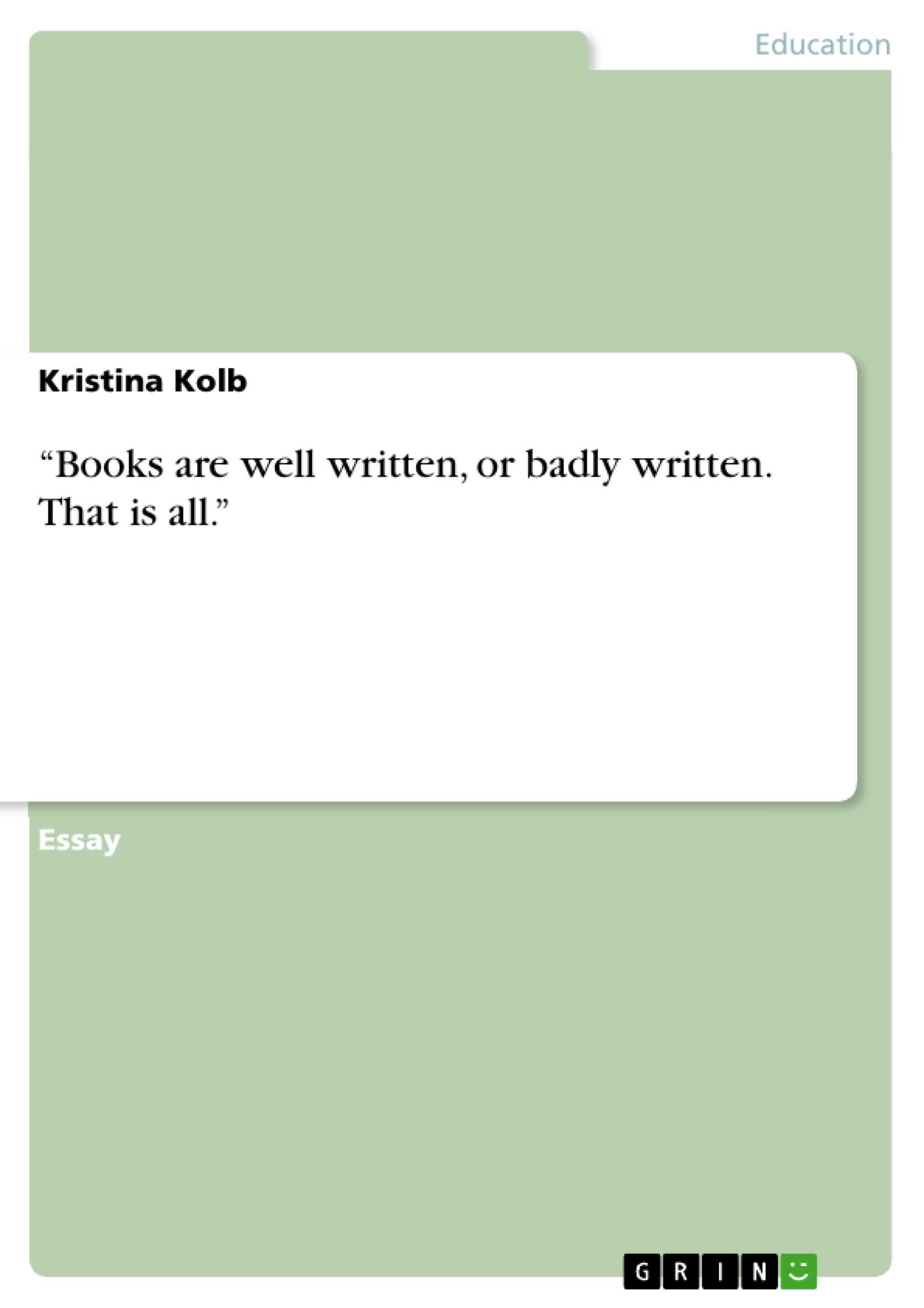Following French Symbolism and Decadence movements, the late 19th century bore witness to the rise of Aestheticism, defined and promoted by authors such as Théophile Gautier, Walter Pater and Oscar Wilde. As put forward by Pater , life consists of nothing more than “impressions, images (and) sensations” and literature was to maximize these “flickering” moments. Influenced by Gautier and Pater, Wilde declared in his famous preface to The Picture of Dorian Gray that “all art is quite useless” , denying that there was such a thing as an “immoral” book and condemning utilitarianism in literature. While he acknowledged that “the moral life of man forms part of the subject-matter of the artist”, he rigidly opposed the opinion put forward by writers such as Orwell that all art is simultaneously propaganda. Nevertheless, the aforementioned preface was not only written as a reaction against Victorian literature, but also being written a year after the first publication of the book, giving it the appearance of an act of self-defense against harsh criticism and casting a shadow of doubt over its face-value. Furthermore, Wilde does make concessions to different interpretations of a text, even if at the reader’s own risk. In the light of this, the question remains in how far Wilde’s view is applicable to texts written in a different context, bearing in mind both author intentionality and reader interpretation. I will focus on Mansfield’s story The Garden Party and three key passages from Gibbon’s Sunset Song in order to analyze with reference to Wilde’s statement in order to analyze its validity in the context of these two writers.
Inhaltsverzeichnis (Table of Contents)
- Aestheticism and Instrumentalism
- Katherine Mansfield and Lewis Grassic Gibbon
- Gibbon's Artistic Use of Language
- Mansfield's Use of Symbols and Colors
- Modernist Techniques and Their Political Implications
- The Political Impact of Rhythm and Structure
- The Role of Personal Experiences and Perception
- Gibbon's Representation of Scotland
- Artistic Qualities and the Reader's Perception
- Literary Theory and the Role of the Reader
- Conclusion
Zielsetzung und Themenschwerpunkte (Objectives and Key Themes)
The main objective of this text is to analyze the relationship between aestheticism and instrumentalism in literature, specifically focusing on the works of Katherine Mansfield and Lewis Grassic Gibbon. The text aims to challenge the notion that these two approaches are mutually exclusive, arguing that literary value and social/political propaganda can coexist.
- The concept of aestheticism and its impact on literature.
- The role of author intentionality and reader interpretation.
- The interplay of language, symbolism, and literary techniques in conveying both aesthetic and instrumental messages.
- The influence of personal experiences and social contexts on the interpretation of texts.
- The potential for both aesthetic and instrumental meanings to coexist in a single literary work.
Zusammenfassung der Kapitel (Chapter Summaries)
- Aestheticism and Instrumentalism: This chapter introduces the concepts of aestheticism and instrumentalism and explores Oscar Wilde's views on the role of morality and utilitarianism in literature. It raises the question of whether Wilde's perspective applies to texts written in different contexts.
- Katherine Mansfield and Lewis Grassic Gibbon: This chapter introduces Katherine Mansfield and Lewis Grassic Gibbon as two modernist authors who, despite their seemingly contrasting approaches to literature, both demonstrate a mastery of language and stylistic innovation.
- Gibbon's Artistic Use of Language: This chapter examines Gibbon's unique approach to language in his novel Sunset Song, highlighting his creation of a hybrid Scots language and his innovative use of "you" to create intimacy between the reader and the protagonist.
- Mansfield's Use of Symbols and Colors: This chapter explores Mansfield's use of symbolism, particularly color, in her story The Garden Party, highlighting the significance of sensory perception in conveying atmosphere and mood.
- Modernist Techniques and Their Political Implications: This chapter discusses how modernist techniques such as free indirect discourse, internal focalization, and streams of consciousness contribute to both the aesthetic and political dimensions of the authors' works.
- The Political Impact of Rhythm and Structure: This chapter explores the impact of rhythm and structure in the works of both authors, highlighting how these elements can contribute to the portrayal of social and political themes.
- The Role of Personal Experiences and Perception: This chapter examines the influence of personal experiences and perception on the authors' work, arguing that both Mansfield's and Gibbon's texts are deeply influenced by their own lives and perspectives.
- Gibbon's Representation of Scotland: This chapter analyzes Gibbon's representation of Scotland in Sunset Song, highlighting the social and political themes embedded within the text, while also acknowledging the aesthetic value of his language and storytelling.
- Artistic Qualities and the Reader's Perception: This chapter discusses how the artistic qualities of the texts can sometimes overshadow their social and political messages, leading readers to focus primarily on the aesthetic experience.
- Literary Theory and the Role of the Reader: This chapter explores the role of the reader in interpreting literary texts, emphasizing that meaning is not inherent in the text itself but is constructed through the reader's engagement with it.
Schlüsselwörter (Keywords)
The key themes and concepts explored in this text include aestheticism, instrumentalism, author intentionality, reader interpretation, language, symbolism, modernist techniques, personal experience, social context, political themes, literary value, and the relationship between art and society.
- Quote paper
- Kristina Kolb (Author), 2007, “Books are well written, or badly written. That is all.”, Munich, GRIN Verlag, https://www.grin.com/document/142057



